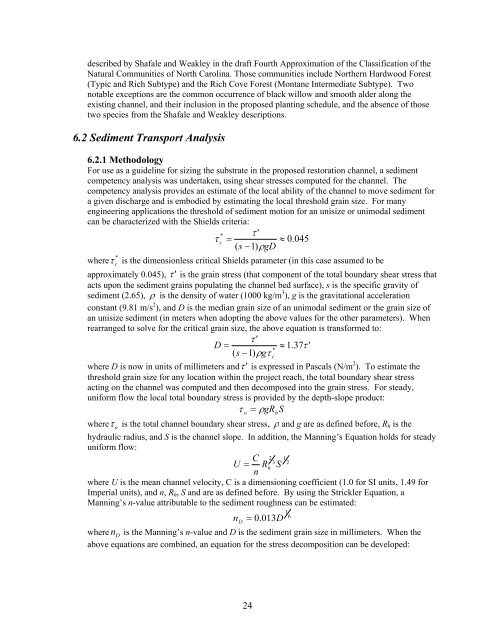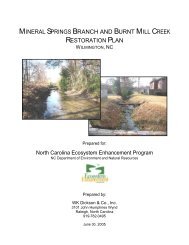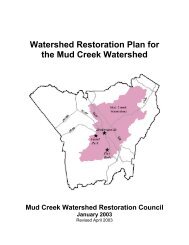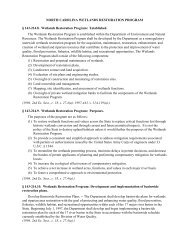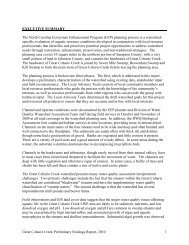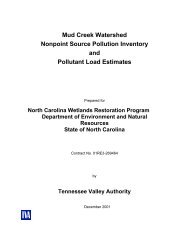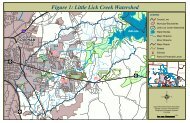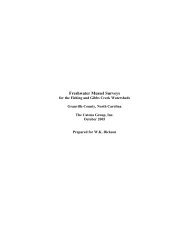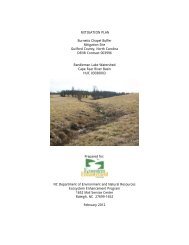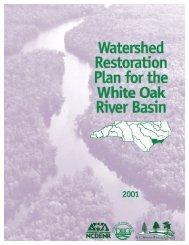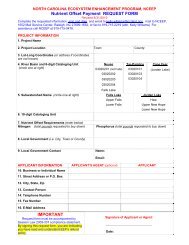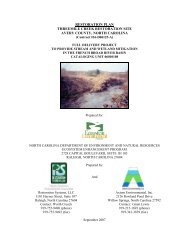RESTORATION PLAN Glade Creek Stream Restoration Alleghany ...
RESTORATION PLAN Glade Creek Stream Restoration Alleghany ...
RESTORATION PLAN Glade Creek Stream Restoration Alleghany ...
You also want an ePaper? Increase the reach of your titles
YUMPU automatically turns print PDFs into web optimized ePapers that Google loves.
described by Shafale and Weakley in the draft Fourth Approximation of the Classification of theNatural Communities of North Carolina. Those communities include Northern Hardwood Forest(Typic and Rich Subtype) and the Rich Cove Forest (Montane Intermediate Subtype). Twonotable exceptions are the common occurrence of black willow and smooth alder along theexisting channel, and their inclusion in the proposed planting schedule, and the absence of thosetwo species from the Shafale and Weakley descriptions.6.2 Sediment Transport Analysis6.2.1 MethodologyFor use as a guideline for sizing the substrate in the proposed restoration channel, a sedimentcompetency analysis was undertaken, using shear stresses computed for the channel. Thecompetency analysis provides an estimate of the local ability of the channel to move sediment fora given discharge and is embodied by estimating the local threshold grain size. For manyengineering applications the threshold of sediment motion for an unisize or unimodal sedimentcan be characterized with the Shields criteria:* 'c 0.045( s 1)gD* cwhere is the dimensionless critical Shields parameter (in this case assumed to beapproximately 0.045), ' is the grain stress (that component of the total boundary shear stress thatacts upon the sediment grains populating the channel bed surface), s is the specific gravity ofsediment (2.65), is the density of water (1000 kg/m 3 ), g is the gravitational accelerationconstant (9.81 m/s 2 ), and D is the median grain size of an unimodal sediment or the grain size ofan unisize sediment (in meters when adopting the above values for the other parameters). Whenrearranged to solve for the critical grain size, the above equation is transformed to: 'D 1.37'*( s 1)gcwhere D is now in units of millimeters and ' is expressed in Pascals (N/m 2 ). To estimate thethreshold grain size for any location within the project reach, the total boundary shear stressacting on the channel was computed and then decomposed into the grain stress. For steady,uniform flow the local total boundary stress is provided by the depth-slope product: o gR hSwhere ois the total channel boundary shear stress, and g are as defined before, R h is thehydraulic radius, and S is the channel slope. In addition, the Manning’s Equation holds for steadyuniform flow:C 2 1R3 S2U hnwhere U is the mean channel velocity, C is a dimensioning coefficient (1.0 for SI units, 1.49 forImperial units), and n, R h , S and are as defined before. By using the Strickler Equation, aManning’s n-value attributable to the sediment roughness can be estimated:n D 0.013Dwhere n Dis the Manning’s n-value and D is the sediment grain size in millimeters. When theabove equations are combined, an equation for the stress decomposition can be developed:1624


